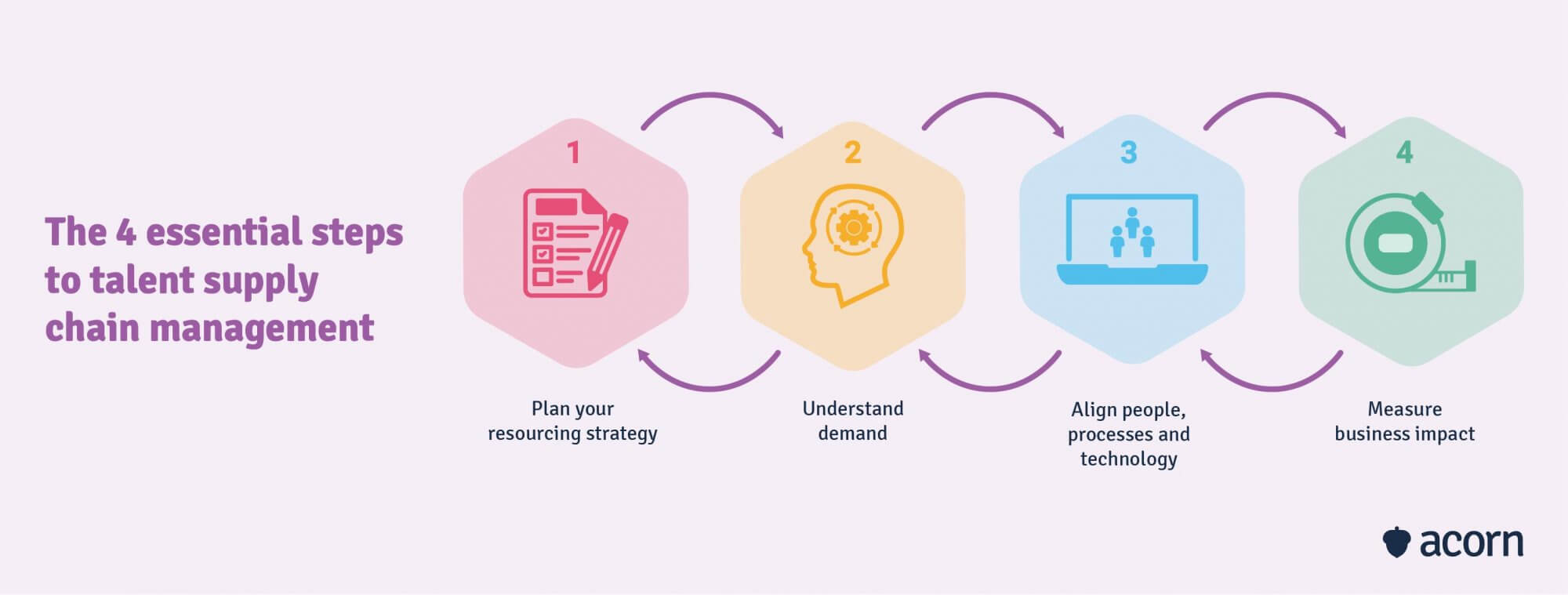How Talent Supply Chain Management Can Boost Productivity and Growth
Reading Time:

Lead the pack with the latest in strategic L&D every month— straight to your inbox.
SubscribeBy now, you probably know that workforce planning is key to finding the right talent for your business—at the right time and the right cost.
But how do you actually make that happen in practice? Well, one sure way of streamlining your workforce and talent is to build and manage a talent supply chain.
Let’s dive into the details of a talent supply chain and how it will transform your business.
What is talent supply chain management?
Talent supply chain management is a process used to find the right talent to meet the workforce requirement of a company, and to find that talent in the most efficient and effective way possible. Businesses use a talent supply chain to maintain the workforce needed to support their provided services in the face of talent supply shortages and turnover.
The talent supply chain management model
The talent supply chain management model (or framework) is a method of building a reliable talent pipeline to align your workforce with your broader business goals. There are four essential steps to building a strong and expertly managed supply chain for your business.

Step 1: Plan your resourcing strategy
The first step to building a successful supply chain is using workforce analytics to identify the gaps in skills and competencies in your organisation. (You might find a skills matrix to be a helpful tool here.) Then you can look at how you’re going to resource filling those gaps, using one of three different approaches.
- Build: Where you use your internal talent to fill talent gaps in your workforce through training and development.
- Buy: Hiring skilled workers from an external talent pool.
- Borrow: “Renting” contingent workers with the required skillsets to fill talent gaps.
Step 2: Understand demand
Demand forecasting is an essential step in your workforce planning journey, utilising your data on past performance, workforce competencies and trends in the workforce such as attrition and turnover. You can use these metrics to map out your business’s most likely workforce demand scenarios in terms of expected growth for the next few years, allowing you to see what talent you’ll be needing, how much and when you’ll need it.
Step 3: Align people, processes and technology
In this step, you need to bring several groups to the table to collaborate on the talent supply chain. This includes your operations, IT and HR leaders, who will need to work together to create an integrated approach to measuring, planning and managing talent. You’ll need the co-operation and skills of each group if you want your talent supply chain management to be strong and effective.
Step 4: Measure business impact
Just as with any aspect of workforce planning, building a talent supply chain is an ongoing process. You can’t just follow the steps once and expect your business to perpetually benefit from the result. It’s important that you continue to collect data relating to your workforce so that you can keep planning your talent supply chain in an ever-changing industry.
Why talent supply chain management will always be important
As we said, building your talent supply chain—just like performing workforce planning—is an ongoing process. It’s not something you can set and forget, but rather a process that needs constant monitoring, planning, and reassessment. Without this level of attention, your supply chain will stagnate and leave you right where you started rather than reaping the benefits of continuing analysis and action.

Retaining valuable employees
When developed properly, your talent supply chain will increase staff retention. Just like workforce planning, which aims to find the right talent for the right cost, your talent supply chain should do the same. What’s more, your employees will thank you for providing them with the professional development required to progress their careers further in your organisation.
In an ideal world, your talent supply chain will set your employees up with appropriate compensation, benefits, development and engagement in your business, incentivising them to stay. 94% of employees say they would stay with their company longer if it invested in their training and development.
This is why here at Acorn, we’ve pioneered the first performance learning management system (PLMS) to tangibly link learning and performance. People crave paths to excellence, but are bogged down by too much content and too little time to do it. A PLMS cuts the fat away, allowing learners to grow and excel in precisely the ways that positively impact outcomes for the business and their own professional development.
Tackling talent shortages
SHRM reported in its 2021-2022 State of the Workplace study that 84% of organisations experienced talent shortages in 2021. Building your talent supply chain means you can identify the gaps in your workforce in terms of skills and competencies. Once you know where your workforce falls short, you’ll be able to address the issue by finding the skilled talent to fix it. And, according to your developed resourcing strategy, you’ll have an idea about exactly where to source your talent from.
Preparing for changes in the industry
The fact is that nothing is set in stone, and the talent supply chain can help you set up your organisation and its workforce for whatever changes the future may bring. Using a combination of historical workforce data and demand forecasting, you’ll be able to predict what changes and scenarios are likely to occur that will affect your industry, allowing you to plan how to meet (or even tackle) those changes. The ability to be flexible but strong in how you address change is a key step to keeping your competitive edge in the market.
Benefits to productivity and growth
At their core, businesses are just a group of people doing work. Whilst this is perhaps over-simplifying something very complex, it highlights the biggest barrier to achieving your organisational priorities in terms of productivity and growth. That is, not having the right people in the right place and at the right time to do the work required.
Let’s lump productivity and growth together under the banner of performance. You’ll find that there are numerous ways a talent supply chain can improve an organisation’s performance.
- A focus on management by objectives
- Performance evaluations
- A participative style of management
- Employee engagement programs.

Key takeaways
Whether you’re undertaking workforce planning or just want to be ready to tackle your recruitment and talent gaps, you’ll want to look into talent supply chain management. It’s a process that will make your recruitment, onboarding, training and workforce development practices more efficient, effective and streamlined, allowing you to reach your organisational goals with greater ease and gain a competitive advantage over your opponents.